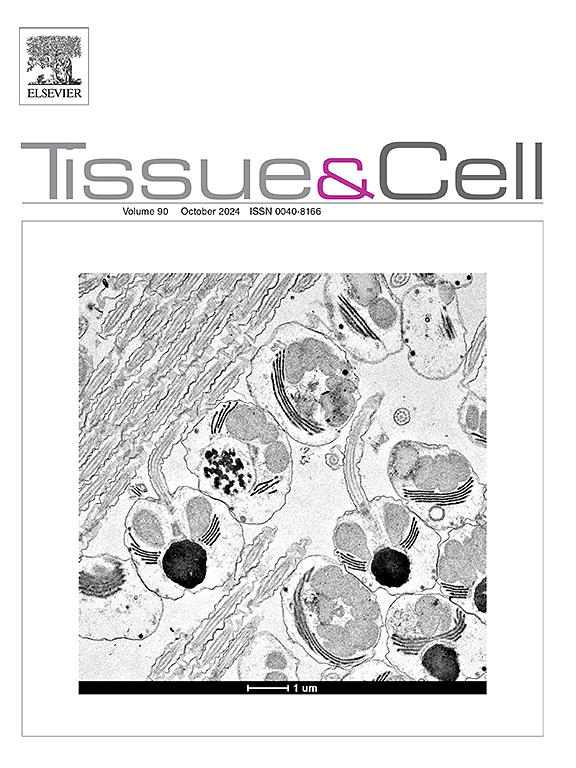Pooled umbilical cord-derived MSCs retain key phenotypic and immunomodulatory properties – A path toward consistent manufacturing
IF 2.7
4区 生物学
Q1 ANATOMY & MORPHOLOGY
引用次数: 0
Abstract
Mesenchymal stromal stem cells (MSCs) represent a promising cell therapy tool, by merit of their regenerative and unique immunomodulatory properties. However, their clinical utility is often hindered by batch-to-batch variability, which is the result of several factors, particularly those of donor heterogeneity and differences in manufacturing. To address this issue, we developed a protocol for pooling umbilical cord-derived MSCs (UC-MSCs) from multiple donors that demonstrates comparable characteristics across pooled and single donor MSCs. We see this as a basis to generate a more homogenous and scalable cell products in the future, allowing for low passage manufacture, termed equipotent MSCs (EQ-MSCs). We characterized EQ-MSCs in comparison to UC-MSCs through extensive phenotypic analysis and by functional and immunological assessment. We demonstrate that EQ-MSCs retain the characteristic phenotypic features of single donor MSCs, with stable expression across multiple passages. Morphological evaluation of mixed donor cultures showed no significant alterations in cellular shape or growth patterns. The analysis of multilineage differentiation capacity demonstrated equivalent adipogenic, osteogenic, and chondrogenic potential, to single donor UC-MSCs. Strong colony forming ability of EQ-MSCs, indicative of preserved clonogenic potential, was also demonstrated. In terms of function, EQ-MSCs expressed key inhibitory molecules, including PD-L1, PD-L2, B7-H3, and adhesion molecule ICAM-1, with further upregulation upon IFN-γ priming, suggesting their capacity for enhanced immunomodulatory profile in response to an inflammatory environment. Functional co-culture assays with human PBMCs revealed a dose-dependent suppression of T cell proliferation, where EQ-MSCs showed comparable immunomodulatory activity to UC-MSCs. Our results support the pooling strategy of UC-MSCs as a viable strategy toward increasing product homogeneity, while at the same time maintaining key biological features.
汇集脐带来源的间充质干细胞保留了关键的表型和免疫调节特性-通往一致制造的途径
间充质干细胞(MSCs)因其再生和独特的免疫调节特性而成为一种很有前途的细胞治疗工具。然而,它们的临床应用往往受到批次差异的阻碍,这是几个因素的结果,特别是供体的异质性和制造的差异。为了解决这一问题,我们开发了一种汇集来自多个供体的脐带来源的间充质干细胞(UC-MSCs)的方案,该方案显示了汇集的间充质干细胞和单一供体间充质干细胞的可比性。我们认为这是未来产生更均匀和可扩展的细胞产品的基础,允许低传代制造,称为等能MSCs (EQ-MSCs)。通过广泛的表型分析以及功能和免疫学评估,我们将EQ-MSCs与UC-MSCs进行了比较。我们证明EQ-MSCs保留了单一供体MSCs的典型表型特征,并在多个传代中稳定表达。混合供体培养的形态学评价显示细胞形状或生长模式没有显著改变。多谱系分化能力分析显示,与单一供体UC-MSCs相比,其具有相同的成脂、成骨和成软骨潜能。结果表明,EQ-MSCs具有较强的集落形成能力,表明其具有克隆生成潜能。在功能方面,EQ-MSCs表达了关键的抑制分子,包括PD-L1、PD-L2、B7-H3和粘附分子ICAM-1,并在IFN-γ启动时进一步上调,表明它们在炎症环境下具有增强的免疫调节能力。与人pbmc的功能共培养实验显示,EQ-MSCs对T细胞增殖的抑制具有剂量依赖性,其中EQ-MSCs表现出与UC-MSCs相当的免疫调节活性。我们的研究结果支持UC-MSCs的汇集策略是一种可行的策略,可以提高产品的同质性,同时保持关键的生物学特性。
本文章由计算机程序翻译,如有差异,请以英文原文为准。
求助全文
约1分钟内获得全文
求助全文
来源期刊

Tissue & cell
医学-解剖学与形态学
CiteScore
3.90
自引率
0.00%
发文量
234
期刊介绍:
Tissue and Cell is devoted to original research on the organization of cells, subcellular and extracellular components at all levels, including the grouping and interrelations of cells in tissues and organs. The journal encourages submission of ultrastructural studies that provide novel insights into structure, function and physiology of cells and tissues, in health and disease. Bioengineering and stem cells studies focused on the description of morphological and/or histological data are also welcomed.
Studies investigating the effect of compounds and/or substances on structure of cells and tissues are generally outside the scope of this journal. For consideration, studies should contain a clear rationale on the use of (a) given substance(s), have a compelling morphological and structural focus and present novel incremental findings from previous literature.
 求助内容:
求助内容: 应助结果提醒方式:
应助结果提醒方式:


